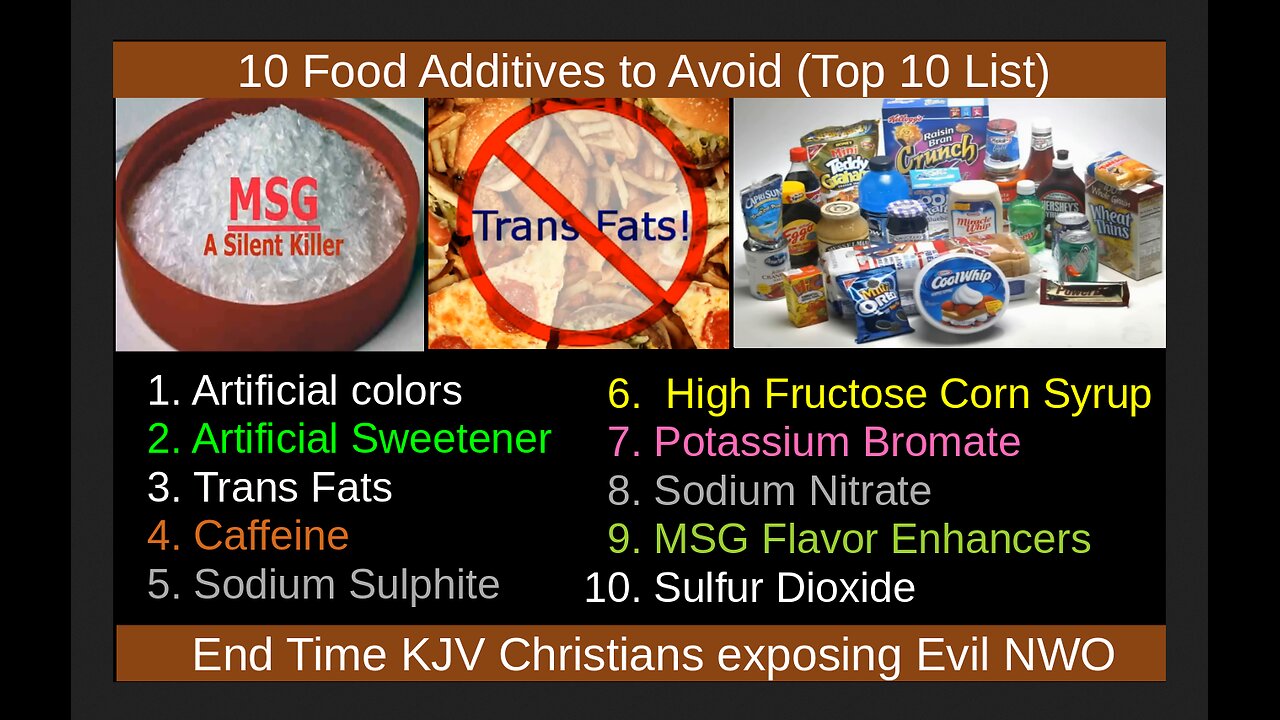Premium Only Content

10 Food Additives to Avoid (Top 10 List)
There is no doubt that most of the packaged food we buy at the grocery store is full of harmful additives, preservatives, and artificial flavors and colors, but once in a while you come across some innocent sounding names that may not sound so suspiscious but upon investigation you find out that they are quite harmful.
The most exposed victims to the dire consequences of additives are families that enjoy consuming mainly processed foods. Because some are more toxic than others, next time you are heading to the supermarket to shop for groceries, watch out for the Top 10 following additives:
1. Artificial colors.
Artificial colors are actually made from coal, as in the stuff they burn to generate heat and electricity. It was not ever meant as food to start with, and should never be added in food now.
2. Artificial Sweetener
Research has found that the artificial sweetener is a popular contaminant in waste water, surface water, and ground water. Recent tests have taken water samples from 19 U.S. drinking water treatment plants serving more than 28 million people to be examined for sucralose.
Don't let any brand name or slogan fool you. Sucralose is not just any magical calorie-free sugar, despite Splenda's famous slogan, "Made from sugar, so it tastes like sugar."
3. Trans Fats:
Have you ever walked in Taco Bell and on their menu board it says we only utilize Trans Fat oils. Don't be conned by the signs, it is not good news for your diet, in fact it means the opposite.
4. Caffeine:
Caffeine can be naturally found in tea, coffee, and cocoa. It can equally be added to many soft drinks. It is one of the few drugs -- a stimulant -- added to foods. Caffeine is dangerous as it promotes stomach-acid secretion, raised blood pressure (temporarily), and dialates some blood vessels while constricting others.
5. Sodium Sulphite:
According to the FDA, approximately one in 100 people are allergic or have a sensitivity to sulfites in food. Individuals who are sulfite sensitive may suffer from asthma, headaches, breathing problems and rashes.
6. High Fructose Corn Syrup:
High fructose corn syrup is a highly-refined artificial sweetener which is the No.1 source of calories in the United States. It is found in almost all processed foods. HFCS packs on the pounds faster than any other ingredient, elevates your bad cholesterol levels, and contributes to the development of diabetes and tissue damage.
7. Potassium Bromate:
Potassium bromate is one of the best dough improvers in the bakery business. Under controlled baking conditions, potassium bromate is converted into potassium bromide, a harmless additive to consumers. Scientific evidence implicate the bromate substance with possible carcinogens and has been removed as an acceptable additive for flour treatment.
8. Sodium Nitrate:
If you fancy meat and especially processed meat products, then it is mandatory to check the percentage of sodium nitrates/nitrites that these foods contain. Because the nitrates are a preservative, they are generally considered harmless. However, when they enter the body and are digested, they break down into carcinogenic substances. The nitrates are known to be hazardous to health and have even been some attempts to vote it out of the meat industry. Yet, they are not banned form the industry simply because they have the ability to turn the meat bright red.
9. MSG Flavor Enhancers:
The MSG flavor enhancer constitutes an excitotoxin known to cause over-excitation of the cells, even to the point of severe damage and death. At the same time, studies show that the E621 or MSG disturbs the hunger neurotransmitters to the brain, particularly the ones that are associated with the saturation sensation and hence, it is yet another factor that can contribute to obesity. The Monosodium Glutamate can be typically found in soups, chips, dressings, frozen foods and other aliments found in restaurants.
10. Sulfur Dioxide:
At this point, the use of sulfur dioxide (E220) is completely forbidden in the US and several countries in Europe. The most common utilization of sulfur dioxide in the food industry comprised of maintaining the appearance and taste of dried fruits and vegetables. While it may preserve the taste and looks, the substance will surely destroy important nutrients present in these aliments (vitamins B1 and E).
Credits to: Top 10 List
-
 LIVE
LIVE
Barry Cunningham
3 hours agoTRUMP DAILY BRIEFING: PRESIDENT TRUMP PRESS CONFERENCE | DEMOCRATS IN PANIC!
3,868 watching -
 1:20:08
1:20:08
Redacted News
2 hours agoPutin smells a TRAP as Ukraine agrees to Trump's U.S. ceasefire plan | Redacted w Clayton Morris
90.1K90 -
 51:59
51:59
Candace Show Podcast
3 hours agoMahmoud Khalil’s Detainment: Fighting Terrorism Or Speech? | Candace Ep 158
55.5K141 -
 LIVE
LIVE
Dr Disrespect
7 hours ago🔴LIVE - DR DISRESPECT - PUBG - PRO TACTICALLY WINNING
2,584 watching -
 1:02:40
1:02:40
In The Litter Box w/ Jewels & Catturd
22 hours agoUSAID to Staff: Shred and Burn | In the Litter Box w/ Jewels & Catturd – Ep. 760 – 3/12/2025
53.8K19 -
 2:21:38
2:21:38
Darkhorse Podcast
5 hours agoThe 267th Evolutionary Lens with Bret Weinstein and Heather Heying
57.8K26 -
 1:58:45
1:58:45
The Quartering
6 hours agoCorrupt Democrats Caught SHREDDING Evidence, Assassination Plot On Alex Jones, Tariff Fallout & More
126K41 -
 1:27:14
1:27:14
The Officer Tatum
5 hours agoLIVE: Trump and Elon BREAK INTERNET With BRAND NEW TESLA | Officer Tatum Show EP 78
48.1K35 -
 2:10:41
2:10:41
Adam Carolla
1 day agoCatalytic Converter Theft Turns Deadly + UPDATE! Rebuilding Malibu | Adam’s Wild Malibu Trip
27.5K14 -
 47:43
47:43
Russell Brand
8 hours agoWho’s Controlling the Narrative? Iran, Epstein, and the Fight Over Women’s Sports – SF552
175K93